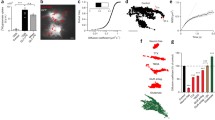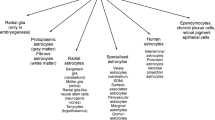Abstract
Neurotransmitter l-glutamate released at central synapses is taken up and “recycled” by astrocytes using glutamate transporter molecules such as GLAST and GLT. Glutamate transport is essential for prevention of glutamate neurotoxicity, it is a key regulator of neurotransmitter metabolism and may contribute to mechanisms through which neurons and glia communicate with each other. Using immunocytochemistry and image analysis we have found that extracellular d-aspartate (a typical substrate for glutamate transport) can cause redistribution of GLAST from cytoplasm to the cell membrane. The process appears to involve phosphorylation/dephosphorylation and requires intact cytoskeleton. Glutamate transport ligands l -trans-pyrrolidine-2,4-dicarboxylate and dl-threo-3-benzyloxyaspartate but not anti,endo-3,4-methanopyrrolidine dicarboxylate have produced similar redistribution of GLAST. Several representative ligands for glutamate receptors whether of ionotropic or metabotropic type, were found to have no effect. In addition, extracellular ATP induced formation of GLAST clusters in the cell membranes by a process apparently mediated by P2 receptors. The present data suggest that GLAST can rapidly and specifically respond to changes in the cellular environment thus potentially helping to fine-tune the functions of astrocytes.



Similar content being viewed by others
References
Conn PJ (2003) Physiological roles and therapeutic potential of metabotropic glutamate receptors. Ann N Y Acad Sci 1003:12–21. doi:10.1196/annals.1300.002
Bennett MR, Balcar VJ (1999) Forty years of amino acid transmission in brain. Neurochem Int 35:269–280. doi:10.1016/S0197-0186(99)00068-6
Watkins JC, Jane DE (2006) The glutamate story. Br J Pharmacol 147(S1):S100–S108
Sheldon AL, Robinson MB (2007) The role of glutamate transporters in neurodegenerative diseases and potential opportunities for intervention. Neurochem Int 51:333–355. doi:10.1016/j.neuint.2007.03.012
Danbolt NC (2001) Glutamate uptake. Prog Neurobiol 65:1–105. doi:10.1016/S0301-0082(00)00067-8
Balcar VJ (2002) Molecular pharmacology of the Na+-dependent transport of acidic amino acids in the mammalian central nervous system. Biol Pharm Bull 25:293–400. doi:10.1248/bpb.25.291
Shigeri Y, Seal RP, Shimamoto K (2004) Molecular pharmacology of glutamate transporters, EAATs and VGLUTs. Brain Res Brain Res Rev 45:250–265. doi:10.1016/j.brainresrev.2004.04.004
Figiel M, Maucher T, Rozyczka J, Bayatti N, Engele J (2003) Regulation of glial glutamate transporter expression by growth factors. Exp Neurol 183:124–135. doi:10.1016/S0014-4886(03)00134-1
Poitry-Yamate CL, Vutskits L, Rauen T (2002) Neuronal-induced and glutamate-dependent activation of glial glutamate transporter function. J Neurochem 82:987–997. doi:10.1046/j.1471-4159.2002.01075.x
Susarla BTS, Robinson MB (2003) Rottlerin, an inhibitor of protein kinase C-δ (PKC-δ), inhibits astrocytic glutamate transport activity and reduces GLAST immunoreactivity by a mechanism that appears to be PKC-δ-independent. J Neurochem 86:635–645. doi:10.1046/j.1471-4159.2003.01886.x
Robinson MB (2002) Regulated trafficking of neurotransmitter transporters: common notes but different melodies. J Neurochem 80:1–11. doi:10.1046/j.0022-3042.2001.00698.x
Beart PM, O’Shea RD (2007) Transporters for l-glutamate: an update on their molecular pharmacology and pathological involvement. Br J Pharmacol 150:5–17. doi:10.1038/sj.bjp.0706949
Minelli A, Barbaresi P, Reimer RJ, Edwards RJ, Conti F (2001) The glial glutamate transporter GLT is localized both in the vicinity and at distance from axon terminals in the rat cerebral cortex. Neuroscience 108:51–59. doi:10.1016/S0306-4522(01)00375-X
Rae C, Moussa CE-H, Griffin JL, Bubb WA, Wallis T, Balcar VJ (2005) Group I and II metabotropic glutamate receptors alter brain cortical metabolic and glutamate/glutamine cycle activity: a 13C NMR spectroscopy and metabolomic study. J Neurochem 92:405–416. doi:10.1111/j.1471-4159.2004.02880.x
Rae C, Moussa CE-H, Griffin JL, Parekh SB, Bubb WA, Hunt NH, Balcar VJ (2006) A metabolomic approach to ionotropic glutamate receptor subtype function: a nuclear magnetic resonance in vitro investigation. J Cereb Blood Flow Metab 26:1005–1017. doi:10.1038/sj.jcbfm.9600257
Moussa CE-H, Mitrovic AD, Vandenberg RJ, Provis T, Rae C, Bubb WA, Balcar VJ (2002) Effects of l-glutamate transport inhibition by a conformationally restricted glutamate analogue (2S, 1′S, 2′R)-2-(carboxycyclopropyl)glycine (l-CCG III) on metabolism in brain tissue in vitro analysed by NMR spectroscopy. Neurochem Res 27:27–35. doi:10.1023/A:1014842303583
Moussa CE-H, Rae C, Bubb WA, Griffin JL, Deters NA, Balcar VJ (2007) Inhibitors of glutamate transport modulate distinct patterns in brain metabolism. J Neurosci Res 85:342–350. doi:10.1002/jnr.21108
Hertz L, Juurlink BHJ, Hertz E, Fosmark H, Schousboe A (1989) Preparation of primary cultures of mouse (rat) astrocytes. In: Shahar A, de Vellis J, Vernadakis A, Haber B (eds) A dissection and tissue culture manual of the nervous system. New York, Alan R. Liss Inc., pp 105–108
Scott HL, Pow DV, Tanneberg AE, Dodd PR (2002) Aberrant expression of glutamate transporter EAAT1 in Alzheimer’s disease. J Neurosci 22:RC206
Otsu N (1979) A thresholding selection method from grey-level histogram. IEEE Trans Syst Man Cybern 9:62–66. doi:10.1109/TSMC.1979.4310076
Kass M, Witkin A, Terzopoulos D (1987) Snakes: active contour models. Int J Comput Vis 1:321–331. doi:10.1007/BF00133570
Curtis H, Barnes SN (1989) Biology, 5th edn. Worth Publishers, New York
DeFife KM, Jenney CR, Colton E, Anderson JM (1999) Disruption of filamentous actin inhibits human macrophage fusion. FASEB J 13:823–832
Bard F, Mazelin L, Pechoux-Longin C, Malhotra V, Jurdic P (2003) Src regulates golgi structure and KDEL receptor-dependent retrograde transport to the endoplasmic reticulum. J Biol Chem 278:46601–46606. doi:10.1074/jbc.M302221200
Balcar VJ, Nguyen KTD, Shin JW, Rae C, Nanitsos EK, Acosta GB, Pow DV, Bennett MR (2004) Rottlerin inhibits (Na+,K+)-ATPase activity but does not cause redistribution of glutamate transporter GLAST in cultured astrocytes. Abstracts of 44th annual meeting of The American Society for Cell Biology, Washington DC, USA, 2004, p 494a, Abstr. No. 1893
Bridges RJ, Kavanaugh MP, Chamberlain AR (1999) A pharmacological review of competitive inhibitors and substrates of high affinity, sodium dependent glutamate transport in the central nervous system. Curr Pharm Des 5:363–379
Shimamoto K, LeBrun B, Yasuda-Kamatani Y, Sakaitani M, Shigeri Y, Yumoto N, Nakajima T (1998) dl-threo-β-benzyloxyaspartate, a potent blocker of excitatory amino acid transporters. Mol Pharmacol 53:195–201
Shimamoto K, Sakai R, Takaoka K, Yumoto N, Nakajima T, Amara SG, Shigeri Y (2004) Characterization of novel l-threo-benzyloxyaspartate derivatives, potent blockers of the glutamate transporters. Mol Pharmacol 65:1008–1015. doi:10.1124/mol.65.4.1008
Schoepp DD, Smith CG, Lodge D, Miller JD, Leander JD, Sacaan AI, Lunn WHW (1991) dl-(Tetrazol-5-yl) glycine: a novel and highly potent NMDA receptor agonist. Eur J Pharmacol 203:237–243. doi:10.1016/0014-2999(91)90719-7
Ong WY, Motin LG, Hansen MA, Dias LS, Bennett MR, Balcar VJ (1997) A P2 purinoceptor blocker suramin antagonizes NMDA receptors and protects against excitatory behaviour caused by NMDA receptor agonist (RS)-(Tetrazol-5-yl)-glycine in rats. J Neurosci Res 49:627–638. doi:10.1002/(SICI)1097-4547(19970901)49:5<627::AID-JNR13>3.0.CO;2-S
Yamada KA, Tang C-M (1993) Benzothiadiazides inhibit rapid glutamate desensitization and enhance rapid glutamatergic synaptic currents. J Neurosci 13:3904–3915
Schoepp DD, Goldsworthy J, Johnson B, Salhoff CR, Baker SR (1994) 3,5-Dihydroxyphenylglycine is a highly selective agonist for phosphoinositide-linkedmetabotropic glutamate receptors in the rat hippocampus. J Neurochem 63:769–772
Shimamoto K, Ohfune Y (1996) Syntheses and conformational analyses of glutamate analogs: 2-(2-carboxy-3-substituted-cyclopropyl)glycines as useful probes for excitatory amino acid receptors. J Med Chem 39:407–423. doi:10.1021/jm9502908
Dowd LA, Robinson MB (1996) Rapid stimulation of EAAC1-mediated Na+-dependent l-glutamate transport activity in C6 glioma cells by phorbol esters. J Neurochem 67:508–516
Daniels KK, Vickroy TW (1999) Reversible activation of glutamate transport in rat brain glia by protein kinase C and an okadaic acid-sensitive phosphoprotein phosphatase. Neurochem Res 24:1017–1025. doi:10.1023/A:1021004809991
Kimmich GA, Roussie J, Manglapus M, Randles J (2001) Characterization of Na+-coupled glutamate aspartate transport by rat brain astrocyte line expressing GLAST and EAAC1. J Membr Biol 182:17–30
Kontny E, Kurowska M, Szczepanska K, Maslinski W (2000) Rottlerin, a PKC isozyme-selective inhibitor, affects signalling events, cytokine production in human monocytes. J Leukoc Biol 67:249–258
Bull ND, Barnett NL (2002) Antagonists of protein kinase C inhibit rat retinal glutamate transport activity in situ. J Neurochem 81:472–480. doi:10.1046/j.1471-4159.2002.00819.x
Koch HP, Kavanaugh MP, Esslinger CS, Zerangue N, Humphrey JM, Amara SG, Chamberlin AR, Bridges RJ (1999) Differentiation of substrate and nonsubstrate inhibitors of the high-affinity, sodium-dependent glutamate transporters. Mol Pharmacol 56:1095–1104
Cooper B, Chebib M, Shen J, King NJC, Darvey IG, Kuchel PW, Rothstein JD, Balcar VJ (1998) Structural selectivity and molecular nature of l-glutamate transport in cultured human fibroblasts. Arch Biochem Biophys 353:356–364. doi:10.1006/abbi.1998.0626
Dunlop J, Lou Z, McIlvain HB (1999) Properties of excitatory amino acid transport in the human U373 astrocytoma cell line. Brain Res 839:235–242. doi:10.1016/S0006-8993(99)01714-X
Anderson CM, Bridges RJ, Chamberlin AR, Shimamoto K, Yasuda-Kamatani Y, Swanson RA (2001) Differing effects of substrate and non-substrate transport inhibitors on glutamate uptake reversal. J Neurochem 79:1207–1216. doi:10.1046/j.1471-4159.2001.00668.x
Jensen AA, Brauner-Osborne H (2004) Pharmacological characterization of human excitatory amino acid transporters EAAT1, EAAT2 and EAAT3 in a fluorescence-based membrane potential assay. Biochem Pharmacol 7:2115–2127. doi:10.1016/j.bcp.2004.02.013
Bridges RJ, Esslinger CS (2005) The excitatory amino acid transporter: pharmacological insights on substrate and inhibitor specificity of the EAAT subtypes. Pharmacol Ther 107:271–285. doi:10.1016/j.pharmthera.2005.01.002
Balcar VJ, Takamoto A, Yoneda Y (2001) Neurochemistry of l-glutamate transport in the CNS: a review of thirty years of progress. Collect Czech Chem Commun 66:1315–1340. doi:10.1135/cccc20011315
Takamoto A, Quiggin LB, Lieb I, Shave E, Balcar VJ, Yoneda Y (2002) Differences between d- and l-aspartate binding sites on glutamate transporters in frozen sections of rat brain. Life Sci 70:991–1001. doi:10.1016/S0024-3205(01)01478-3
Condorelli DF, Dell’Albani P, Corsaro M, Barresi V, Giuffrida-Stella AM (1993) AMPA-selective glutamate receptor subunits in astroglial cultures. J Neurosci Res 36:344–356. doi:10.1002/jnr.490360312
Porter JT, McCarthy KD (1997) Astrocytic neurotransmitter receptors in situ and in vivo. Prog Neurobiol 51:439–455. doi:10.1016/S0301-0082(96)00068-8
Rose CR, Ransom BR (1996) Mechanism of H+ and Na+ changes induced by glutamate, kainate and d-aspartate in rat hippocampal slices. J Neurosci 16:5393–5404
Sullivan R, Rauen T, Fischer F, Wießner M, Grewer C, Bicho A, Pow DV (2004) Cloning, transport properties and differential localization of two splice variants of GLT-1 in the rat CNS: implications for CNS glutamate homeostasis. Glia 45:155–169. doi:10.1002/glia.10317
Pellerin L, Magistretti PJ (1997) Glutamate uptake stimulates Na+, K+-ATPase activity in astrocytes via activation of a distinct subunit highly sensitive to ouabain. J Neurochem 69:2132–2137
Cholet N, Pellerin L, Magistretti PJ, Hamel E (2002) Similar perisynaptic glial localization for the Na+, K+-ATPase alpha 2-subunit and the glutamate transporters GLAST and GLT in the rat somatosensory cortex. Cereb Cortex 12:515–525. doi:10.1093/cercor/12.5.515
Cholet N, Pellerin L, Welker E, Lacombe P, Seylaz J, Magistretti PJ, Bonvento G (2001) Local injection of antisense oligonucleotides targeted to the glial glutamate transporter GLAST decreases the metabolic response to somatosensory activation. J Cereb Blood Flow Metab 21:404–412. doi:10.1097/00004647-200104000-00009
Nanitsos EK, Acosta GB, Saihara Y, Stanton D, Liao LP, Shin JW, Rae C, Balcar VJ (2004) Effects of glutamate transport substrates and glutamate receptor ligands on the activity of Na+/K+-ATPase in brain tissue in vitro. Clin Exp Pharmacol Physiol 31:762–769. doi:10.1111/j.1440-1681.2004.04090.x
Gottlieb M, Wang Y, Teichberg VI (2003) Blood-mediated scavenging of cerebrospinal fluid glutamate. J Neurochem 87:119–126. doi:10.1046/j.1471-4159.2003.01972.x
Teichberg VI, Cohen-Kashi-Malina K, Cooper I, Zlotnik A (2009) Homeostasis of glutamate in brain fluids: an accelerated brain-to-blood efflux of excess glutamate is produced by blood glutamate scavenging and offers protection from neuropathologies. Neuroscience 158:301–308. doi:10.1016/j.neuroscience.2008.02.075
Duan S, Anderson CM, Keung EC, Chen Y, Swanson RA (2003) P2X7 receptor mediated release of excitatory amino acids from astrocytes. J Neurosci 23:1320–1328
Coco S, Calegari F, Pravettoni E, Pozzi D, Taverna E, Rosa P, Matteoli M, Verderio C (2003) Storage and release of ATP from astrocytes in culture. J Biol Chem 278:1354–1362. doi:10.1074/jbc.M209454200
Cornell-Bell AH, Finkbeiner SM, Cooper MS, Smith SJ (1990) Glutamate induces calcium waves in cultured astrocytes: long-range glial signalling. Science 247:470–473. doi:10.1126/science.1967852
Haydon PG, Carmignoto G (2006) Astrocyte control of synaptic transmission and vascular coupling. Physiol Rev 86:1009–1031. doi:10.1152/physrev.00049.2005
Acknowledgments
The project was supported by a grant from the Australian Health Management Fund (VJB) and by a Sydney University Sesquicentennial Grant (VJB).
Author information
Authors and Affiliations
Corresponding author
Additional information
The authors J.-W. Shin and K. T. D. Nguyen have contributed equally.
Rights and permissions
About this article
Cite this article
Shin, JW., Nguyen, K.T.D., Pow, D.V. et al. Distribution of Glutamate Transporter GLAST in Membranes of Cultured Astrocytes in the Presence of Glutamate Transport Substrates and ATP. Neurochem Res 34, 1758–1766 (2009). https://doi.org/10.1007/s11064-009-9982-z
Received:
Accepted:
Published:
Issue Date:
DOI: https://doi.org/10.1007/s11064-009-9982-z




